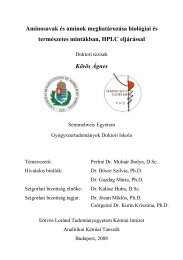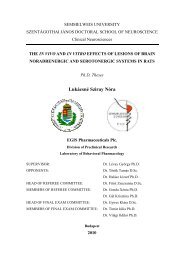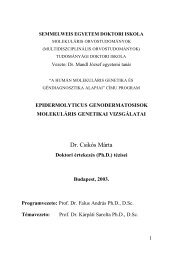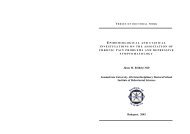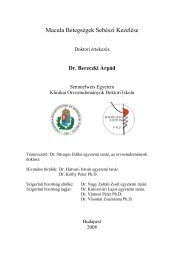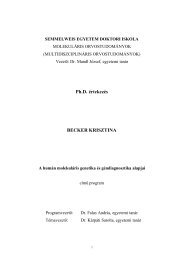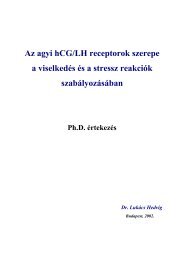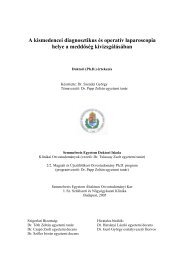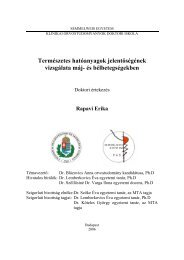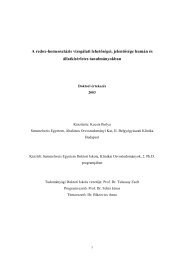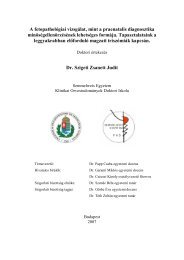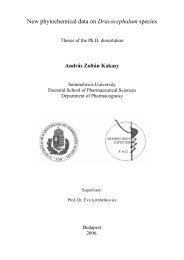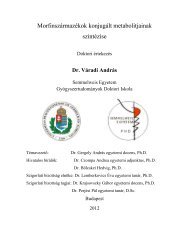GLYCOSIDES IN Viola Tricolor L.
GLYCOSIDES IN Viola Tricolor L.
GLYCOSIDES IN Viola Tricolor L.
Create successful ePaper yourself
Turn your PDF publications into a flip-book with our unique Google optimized e-Paper software.
CHAPTER 2: <strong>IN</strong>TRODUCTION<br />
bonds. Note that k,l Ai is easily confused with the aglycone fragment ( i,j A0),<br />
therefore to avoid uncertainty the subscript 0 was added to the latter [94] (for<br />
sugar fragments i > 0). For simplicity, ions formed by the direct loss of radi-<br />
cals or small neutral molecules are usually specified by reference to the parent<br />
ion (e.g. 0,2 X + –H2O). In some cases, subscripts H, D, or P was added to the<br />
labels, referring to‘hexose’, ‘deoxyhexose’, or ‘pentose’,respectively. Label‘Ei’<br />
designates the loss of water molecules. In some instances, a number in paren-<br />
thesis was added to the label to indicate the position where the sugar unit was<br />
attached to the aglycone.<br />
2.4.3 Structureelucidation<br />
The characterization of flavonoid glycosides by mass spectrometry comprises<br />
the determination of (i) glycosylation types (O-, C-, or mixed glycosides), (ii)<br />
types of the sugar units (hexoses, deoxyhexoses or pentoses), (iii) distribu-<br />
tion of the sugar residues, (iv) order of the glycan sequence, (v) interglycosidic<br />
linkages, (vi) glycosylation position, and (vii) nature of the aglycone. Besides<br />
summarizing papers, which reporte on the determination of the above char-<br />
acteristic markers, this subsection focuses on the identification options of un-<br />
known flavonoid glycosides in complex samples (e.g. plant extracts) with the<br />
emphaseson the differentiation of isomeric compounds.<br />
AlthoughMSfragmentationpatternsmaytheoreticallyvarywiththeinstru-<br />
mentation used, several authors reported that the main fragmentation paths<br />
of flavonoids are independent of the actual ionization mode (ESI, APCI, or<br />
MALDI)orthetypesofanalyzersapplied(QQQ, IT,orQTOF)[92,99–101]. On<br />
the contrary, significant differences could be observed regarding the relative<br />
abundances of fragment ions by using different instrumentation [92, 99, 100].<br />
Therefore, methods based on the presence or absence of distinctive fragment<br />
ions are preferred to techniques, which rely only on relative intensity changes<br />
observed forisomeric compounds.<br />
Similarly,approachesnotrequiringspecialsamplepreparationmethodsare<br />
also favored. Nonetheless, methods including derivatization or complex for-<br />
mation,arealsodiscussediftheyprovidecomplementaryinformationonstruc-<br />
tural elucidation (Sec. 2.4.3.5).<br />
As the majority of the cited references report only on the study of flavones,<br />
flavonols, flavanones, and isoflavones, mass spectroscopic analysis of antho-<br />
21



